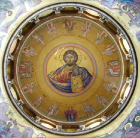Saint Symeon the New Theologian
Dan Fefferman
| Part of the series on Eastern Christianity | |

| |
|
History | |
|
Traditions | |
|
Liturgy and Worship | |
|
Theology | |
Symeon the New Theologian (949–1022) is one of three saints of the Eastern Orthodox church to have been given the title of Theologian (the others are St. John the Apostle and St. Gregory Nazianzen). Born in Galatia and educated at Constantinople, he became abbot of the monastery of St. Mamas.
St. Symeon was a poet who embodied the mystical tradition. He wrote that humans could and should experience God directly. His works influenced the hesychastic controversy of the 14th century.
ReferencesISBN links support NWE through referral fees
- Hilarion Alfeyev, St Symeon the New Theologian and Orthodox Tradition, 2000, Oxford U. Press, ISBN 0-19-827009-7
See also
- Christian mysticism
- Saint Seraphim of Sarov
External links
- Symeon the New Theologian texts in English and Greek, Select Resources
- biography at Greek Orthodox Archdiocese of Australia (accessed September 30 2005)
- The writings of Symeon in Greek, download
Credits
New World Encyclopedia writers and editors rewrote and completed the Wikipedia article in accordance with New World Encyclopedia standards. This article abides by terms of the Creative Commons CC-by-sa 3.0 License (CC-by-sa), which may be used and disseminated with proper attribution. Credit is due under the terms of this license that can reference both the New World Encyclopedia contributors and the selfless volunteer contributors of the Wikimedia Foundation. To cite this article click here for a list of acceptable citing formats.The history of earlier contributions by wikipedians is accessible to researchers here:
The history of this article since it was imported to New World Encyclopedia:
Note: Some restrictions may apply to use of individual images which are separately licensed.